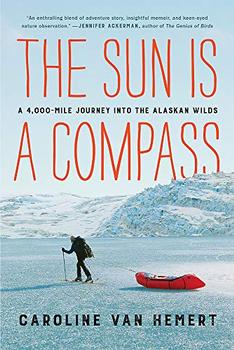Summary | Excerpt | Reviews | Beyond the book | Read-Alikes | Genres & Themes | Author Bio

A 4,000-Mile Journey into the Alaskan Wilds
by Caroline Van HemertCaroline Van Hemert fell in love with her future husband, Pat, in 2001, discovering they shared a passion for nature and wilderness adventure. Ten years later, the couple found themselves disconnected from the outdoors, which they considered an essential part of their being; Caroline writes, "In our commitment to education and jobs, we had neglected what mattered most to us." She also began to feel the pressure of caring for aging parents and the ticking of her biological clock, and realized that her "perception of time shifted from lazy and boundless to precious and finite." As a person who designed and built houses for a living, Pat too, "questioned why he wasted sunny afternoons buried in drywall dust." They decided they needed to "find [their] way home" to the natural world, embarking on a journey from the shores of Washington State to a tiny town in northern Alaska, some 4,000 miles away. The six-month adventure is chronicled in her memoir, The Sun is a Compass.
The first quarter of the narrative covers Van Hemert's life up to the point where she and her husband depart from Bellingham, Washington in March, 2012. She relays how she went from being a bookish child who didn't understand her parents' passion for the outdoors to someone who felt comfortable spending weeks at a time in a tent. She goes on to describe her growing relationship with Pat, her polar opposite, and how they went on to build a life together, finally realizing they weren't happy with the adults they'd become. This section is as fascinating as her account of her adventure, providing an intimate and honest portrait of the author and a clear understanding of why she'd want to undertake such a difficult and dangerous excursion.
The heart of the book is, of course, the remarkable story of the couple's expedition. To put in perspective what they hoped to accomplish, the author mentions that they intended to travel "roadless, trailless terrain through a landscape where glaciers span larger than entire countries," across a distance that was "equivalent to that which separates New York from Stockholm" – all under their own power. As the planner in the family, she was responsible for logistics and had a to-do list as long as her refrigerator. They needed gear to "row, ski, hike, packraft, and canoe," and to purchase and package a thousand pounds of nonperishable food (one evening, she and her sister divided oatmeal into eight hundred individual baggies). They traveled in all kinds of weather (they left Bellingham in a cold March rain that turned into hail); traversed land and sea and raging rivers; braved dangers such as near drowning and attacking grizzly bears; endured hardships (almost starving to death waiting for a late food resupply); and never ceased to revel in the sights, sounds and smells of their environment. There were times I found myself moved by the author's descriptions of the beauty that surrounded her, and her ability to convey the couple's ups and downs as they traveled together really drew me in, making the entire account altogether riveting.
Some are comparing Van Hemert's account to Cheryl Strayed's memoir Wild, but there are significant differences in tone between the two books and, personally, I feel Van Hemert's book is the superior one. While Strayed chronicled her attempt to find herself – a move toward becoming someone new – Van Hemert's work is less introspective and more about returning to the things that make her happiest and give her life meaning. As an outdoorswoman myself, I truly enjoyed every moment of The Sun is a Compass, but others may find it somewhat lacking in emotional depth.
The Sun is a Compass is a marvelous account, perfect for the armchair adventurer and the seasoned traveler alike. Van Hemert's writing is engaging, and she's able to capture the essence of her adventure flawlessly. The book will appeal most to those who enjoy travelogues, memoirs and works about interacting with nature, although the account is so enthralling it will likely appeal to a much broader audience.
![]() This review was originally published in The BookBrowse Review in April 2019, and has been updated for the
March 2020 edition.
Click here to go to this issue.
This review was originally published in The BookBrowse Review in April 2019, and has been updated for the
March 2020 edition.
Click here to go to this issue.

If you liked The Sun Is a Compass, try these:

by Ben Rawlence
Published 2023
In the tradition of Elizabeth Kolbert and Barry Lopez, a powerful, poetic and deeply absorbing account of the "lung" at the top of the world.

by Heather Lende
Published 2021
The writer whom the Los Angeles Times calls "part Annie Dillard, part Anne Lamott" now brings us her quirky and compassionate account of holding local office.
Your guide toexceptional books
BookBrowse seeks out and recommends the best in contemporary fiction and nonfiction—books that not only engage and entertain but also deepen our understanding of ourselves and the world around us.